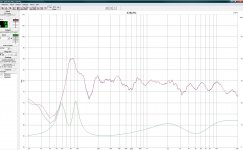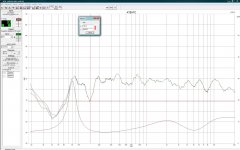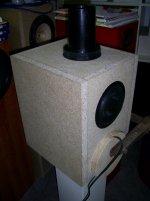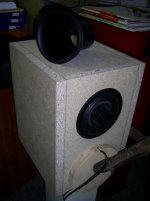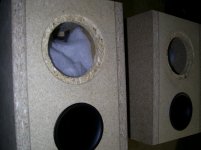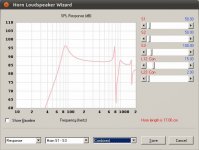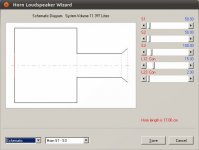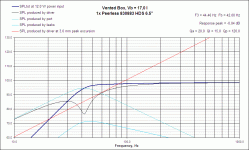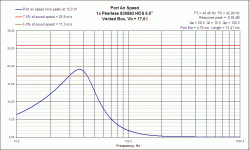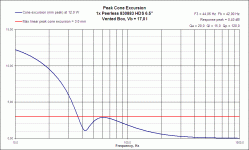I have made a vented box for Visaton driver HX 10 Visaton - Lautsprecher und Zubehör, Loudspeakers and Accessories , but there is a problem. I get a "hole" in response with low point at 147 Hz which is more than 5 dB deep and it was clear that something is wrong even before measurement. I tried closed version and sound is somewhat better but still not good and measurement shows even bigger hole in response. Inner dimensions of the box are 28,1 x 17,3 x 22,2 cm (HxWxD) and outer dimensions are 31,7 x 22,2 x 25,8 cm (HxWxD) and volume is a bit more than 10 liters.
Any idea what is the PROBLEM?
First picture is vented box mesurment, second closed box and the rest are pictures of box itself
Any idea what is the PROBLEM?
First picture is vented box mesurment, second closed box and the rest are pictures of box itself
Attachments
If anybody else answers you, I would say it's reflections and other room related. Try mic close "inserted" to the driver.
My first feeling is similar. Might try measuring them outside where you can be sure the measurements are free of room effects.
because of the nature of sound and its high speed, even with the mic a mm from the cone peeks and trougths that are ariving in and out of phase with the cone will still be recorded. so that wont work
best try outside. i agree it is likely room related
one things for sure its probubly not that horrid mesh you have over the speaker. a mesh that i would remove if i where you. just my preferance
best try outside. i agree it is likely room related
one things for sure its probubly not that horrid mesh you have over the speaker. a mesh that i would remove if i where you. just my preferance
Member
Joined 2009
Probably nothing wrong with your speakers! It looks like a "natural" room interaction. Indoor measurements are only accurate until the first room reflection reaches the microphone. For my room that's about >800Hz. You can see the reflection in the Impulse Response plot. Use an option for a Gated view on your software if you have it.
You can do a near-field measurement for your low-end. Place the microphone as close to the woofer as possible without touching. This will be only accurate below about 200Hz. Note that the port output will not be included.
You can do a near-field measurement for your low-end. Place the microphone as close to the woofer as possible without touching. This will be only accurate below about 200Hz. Note that the port output will not be included.
Thanks for your answers 
Room could be the problem, since I noticed the sam thing in other loudspeaker, it wasn't that noticable but the frequency was the same.
Will try near-field mesurment. Out door isn't an option, since I don't have laptop and mesurment box is conected with USB cable.
In the first picture which is bassreflex mesurment it is possible to see also the peak in response but the impedance curve is close to perfection. Do you think I should try lower frequency tuning?
The mesh is instaled in a way that would leave holes in a basket if I removed it.
Room could be the problem, since I noticed the sam thing in other loudspeaker, it wasn't that noticable but the frequency was the same.
Will try near-field mesurment. Out door isn't an option, since I don't have laptop and mesurment box is conected with USB cable.
In the first picture which is bassreflex mesurment it is possible to see also the peak in response but the impedance curve is close to perfection. Do you think I should try lower frequency tuning?
one things for sure its probubly not that horrid mesh you have over the speaker. a mesh that i would remove if i where you. just my preferance
The mesh is instaled in a way that would leave holes in a basket if I removed it.
Move the speaker around in the room, try different height. If the problem is in the room, moving the speaker will make differences in the FR. I have a similar problem, quite evident when playing George Michael's "My Baby Just Cares For Me" with a sequence from a double bass. If I move in the room there is a place where the sequence has a dip, in other places or outside the sequence plays fine at the same level.Room could be the problem, since I noticed the sam thing in other loudspeaker, it wasn't that noticable but the frequency was the same.
Your tuning is way too high, there is a high peak in the measured response. For a maximally flat response the tuning should be around 55Hz, for a mild peak try around 65Hz. I suspect you used a too large reflex tube, see what you can do to obtain 55-65Hz tuning. IMHO the driver is really optimized for a satellite+sub combination: a closed box of 2-5L switched to the sub at 100-150Hz.In the first picture which is bassreflex mesurment it is possible to see also the peak in response but the impedance curve is close to perfection. Do you think I should try lower frequency tuning?
(Note: I didn't simulate for excursion limit, the tuning has also influence on this)
Ralf
Last edited:
As others have said, the room seems to be to blame... Hornresp closely follows your charted response for the box less the dip at ~150hz, but no resonance issues show up in the range you are having problems.... See attached simulations... [I estimated the port dimensions very roughly, but close enough IMO]...
What I can't figure out, is the purpose of the port in this design. If the speaker is being used as a mid-bass with a sub, then the port is just an opportunity for undesirable resonances, If this is being used full range, a smaller diameter port would create a much more useful tuning to get some useful flat bass response with minimised resonance issues.
What I can't figure out, is the purpose of the port in this design. If the speaker is being used as a mid-bass with a sub, then the port is just an opportunity for undesirable resonances, If this is being used full range, a smaller diameter port would create a much more useful tuning to get some useful flat bass response with minimised resonance issues.
Attachments
Last edited:
Move the speaker around in the room, try different height. If the problem is in the room, moving the speaker will make differences in the FR. I have a similar problem, quite evident when playing George Michael's "My Baby Just Cares For Me" with a sequence from a double bass. If I move in the room there is a place where the sequence has a dip, in other places or outside the sequence plays fine at the same level.
Will try this and see what will happen.
Your tuning is way too high, there is a high peak in the measured response. For a maximally flat response the tuning should be around 55Hz, for a mild peak try around 65Hz. I suspect you used a too large reflex tube, see what you can do to obtain 55-65Hz tuning. IMHO the driver is really optimized for a satellite+sub combination: a closed box of 2-5L switched to the sub at 100-150Hz.
(Note: I didn't simulate for excursion limit, the tuning has also influence on this)
I'm a bit woried about excursion, thats why I would like to have tuning at Fs of driver, and use it as a single unit, without sub. Also vil try to put something in the box to get a smaller volumen. Do you think quick sand in plastik bag will be ok, since it is easy to mesure the volumen?
What I can't figure out, is the purpose of the port in this design. If the speaker is being used as a mid-bass with a sub, then the port is just an opportunity for undesirable resonances, If this is being used full range, a smaller diameter port would create a much more useful tuning to get some useful flat bass response with minimised resonance issues.
Idea is to be used as a full range. In theory the port should be as big as loudspeaker and since there is enought space I decided to use this one. I don't think that smaller diameter would make any differenc or would it?
Wouldn't it be only shorter for the same tuning?
IMO, the box is about the right size and needs to be tuned to about 57 Hz. You need to keep the port sized to avoid air noises. You might need to put a right angle in the port tube for it to be long enough. The response will be about -3 dB at 52 Hz, and that's the best and flattest this driver is apt to do. The port could be 2" by about 5 and a bit inches long. If you make it larger, the required length will be impractical. Did you measure the T-S parameters yourself after some break in? Manufacturers are pretty good about the numbers these days, but I still like to confirm them. Trust but verify!
Last edited:
Idea is to be used as a full range.
Then an enormous oversized hole in the box is acting as an unnecessary opportunity for resonances from the box/port and sound energy from the rear of the driver making their way out of the box.
In theory the port should be as big as loudspeaker
According to what? A port as large as the speaker is actually rather unusual unless you are trying to build a transmission line. In this case, the driver being used has absolutely no need for such an oversized port. The very large diameter and short length is not tuning the box correctly for full range use.
and since there is enought space I decided to use this one.
Port diameter and length is something that is best determined through simulation. Not a "whim."
I don't think that smaller diameter would make any differenc or would it?
Smaller diameter of the same length would be a lower tuning, which is what this box needs if you want it to have a well behaved bass response.
Wouldn't it be only shorter for the same tuning?
I can't come up with any reason that you would want to keep the tuning that you have in play right now, it's resulting in a nasty peak in response that is worse than the lull in response that this thread was started in regards to.
I would switch to a 1.5" diameter x 4-5" length, or 2" x 8"
Regards,
Eric
Could this realy be that big of a problem? But yes this idea did cros my mind.Then an enormous oversized hole in the box is acting as an unnecessary opportunity for resonances from the box/port and sound energy from the rear of the driver making their way out of the box.
I have damping fome and syntetic wool inside, so I don't think that is a problem, will mesure also the port and see what is geting out of it
As far as I know the surface of port should be equal or at least half of surface of driver. This is to avoid any noise created by port itself. I know that because of limitations of design this is rearly used, but I think I can use that size of a port and live with this design.According to what? A port as large as the speaker is actually rather unusual unless you are trying to build a transmission line. In this case, the driver being used has absolutely no need for such an oversized port. The very large diameter and short length is not tuning the box correctly for full range use.
The reason for high tuning frequency is as said before to be able to get out more from this driver in relation to cone displacment. The idea is to have port tuned at Fs of the driver. The simulation didn't look that problematic.Port diameter and length is something that is best determined through simulation. Not a "whim."
Smaller diameter of the same length would be a lower tuning, which is what this box needs if you want it to have a well behaved bass response.
I can't come up with any reason that you would want to keep the tuning that you have in play right now, it's resulting in a nasty peak in response that is worse than the lull in response that this thread was started in regards to.
If you look at mesurmet you can see a prfect impedance respons, I only wish that response could be the same.
I would switch to a 1.5" diameter x 4-5" length, or 2" x 8"
Regards,
Eric
Thanks, will try diffrent port and see or rather hear what happens
I think you absolutely need to download Unibox and play:
Unibox - Unified Box Modeler Loudspeaker Design Software
This will help you answer the following questions:
1) What changes in the FR when changing tuning frequency
2) What will be the maximum power used before the driver reaches its xmax
3) How long a tube should be in relation with its diameter vs the tuning frequency
4) What will be the air speed in the tube
Ralf
Unibox - Unified Box Modeler Loudspeaker Design Software
This will help you answer the following questions:
1) What changes in the FR when changing tuning frequency
2) What will be the maximum power used before the driver reaches its xmax
3) How long a tube should be in relation with its diameter vs the tuning frequency
4) What will be the air speed in the tube
Ralf
I'm using boxsim which is also very good and has already imported visaton drivers database Boxsim - Homepage
Where in Unibox do you see air speed in the tube, since I can't see it on link that you gave. Is there more to this software than it is shown on link?
I just don't want to install all programs that are available and than use it only once.
Where in Unibox do you see air speed in the tube, since I can't see it on link that you gave. Is there more to this software than it is shown on link?
I just don't want to install all programs that are available and than use it only once.
As this deep presents in both configurations, vented and sealed, I don’t think the port can be blamed. It might be room mode or reflections from nearest wall or what else is used as microphone stand. Also , if there is too big measuring resistor connected in series ,the resulting Qts will be higher and you could observe something similar.
Unibox is specialized in low-end tuning (closed, reflex, radiator). Easy and powerful for what it does. You fill data in the first sheet and see detail on another sheet.
For example FR:

or air speed:
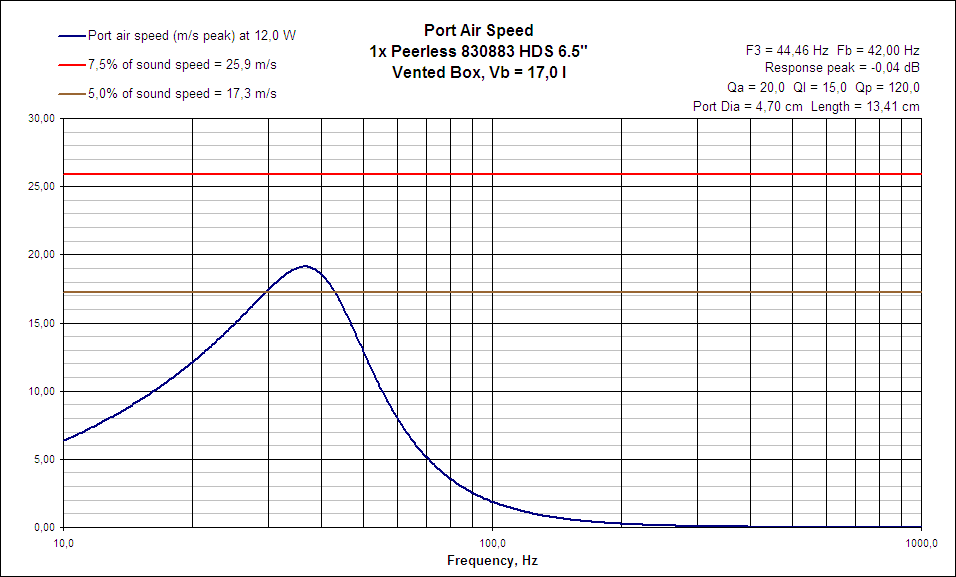
or cone excursion:

Start with 1W as Nominal Power of the driver, see the FR, and only then increase the power to check air speed and cone excursion.
Ralf
For example FR:
or air speed:
or cone excursion:
Start with 1W as Nominal Power of the driver, see the FR, and only then increase the power to check air speed and cone excursion.
Ralf
Attachments
It is probably the room that makes this kind of respons. For mesuring I use ATB pro so I think there isnt a problem and a proper mic stand, all of this shouldn't make any difference at 147 Hz.As this deep presents in both configurations, vented and sealed, I don’t think the port can be blamed. It might be room mode or reflections from nearest wall or what else is used as microphone stand. Also , if there is too big measuring resistor connected in series ,the resulting Qts will be higher and you could observe something similar.
- Status
- This old topic is closed. If you want to reopen this topic, contact a moderator using the "Report Post" button.
- Home
- Loudspeakers
- Multi-Way
- Problem in response
